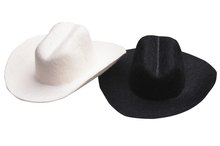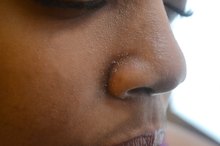How to Get More Air Through Your Nose
Many people have difficulty getting enough air through the nose and breathe primarily through the mouth. Mouth breathing can cause problems such as snoring, dry mouth, sleep problems and fatigue. Issues like a crooked nasal septum, allergies or weak, flimsy nostrils can make nose breathing a challenge. Following a few tips can help you breathe easier 1.
If you are experiencing serious medical symptoms, seek emergency treatment immediately.
Wear nasal dilator strips. Apply a strip on the outside of the bridge of your nose, a little higher than half way up. An adhesive holds the strip in place, and the strip itself is flexible and acts like a spring to pull your nasal passage open. Experiment with different positions on your nose to see if dilator strips will work for you.
How to Get Rid of a Scabby Nose
Learn More
Apply a nasal saline spray into your nostrils to help clear out mucous and act as a mild decongestant. Obtain an over-the-counter spray, or mix 1/2 teaspoon of sea salt and a pinch of baking soda in 1 cup of lukewarm water. Pour the solution into a fine-mist spray bottle for use.
Don’t eat for at least three hours before you go to bed. Eating too soon before bed can cause gastric juices to leak into your nose as you sleep, causing swelling.
How to Take Care of Your Nose
Learn More
Wash your bedsheets often, in the hottest water possible, to deter allergens like dust that might interfere with your breathing.
Practice breathing techniques to clear a stuffy nose. Breathe three breaths lightly through your nose, then hold your breath after the third 1. Hold your breath for as long as possible, then breathe in gently through your nose, as normal 1.
Related Articles
References
- Med Help: 7 Tips to Breathe Better Through Your Nose
- American Academy of Otolaryngology: Fact Sheet--Your Nose, the Guardian of Your Lungs
- Sato K, Shirakawa T, Sakata H, Asanuma S. Effectiveness of the analysis of craniofacial morphology and pharyngeal airway morphology in the treatment of children with obstructive sleep apnoea syndrome. Dentomaxillofac Radiol. 2012;41(5):411–416. doi:10.1259/dmfr/28710443
- Azarbarzin A, Sands SA, Marques M, et al. Palatal prolapse as a signature of expiratory flow limitation and inspiratory palatal collapse in patients with obstructive sleep apnoea. Eur Respir J. 2018;51(2):1701419. doi:10.1183/13993003.01419-2017
- Leboulanger N. Nasal obstruction in children. Eur Ann Otorhinolaryngol Head Neck Dis. 2016;133(3):183-6. doi:10.1016/j.anorl.2015.09.011
- May JR, Dolen WK. Management of allergic rhinitis: a review for the community pharmacist. Clin Ther. 2017;39(12):2410-2419. doi:10.1016/j.clinthera.2017.10.006
- Wheatley LM, Togias A. Clinical practice. Allergic rhinitis. N Engl J Med. 2015;372(5):456–463. doi:10.1056/NEJMcp1412282
- Rowland S, Aiyappan V, Hennessy C, et al. Comparing the efficacy, mask leak, patient adherence, and patient preference of three different CPAP interfaces to treat moderate-severe obstructive sleep apnea. J Clin Sleep Med. 2018;14(1):101-108. doi:10.5664/jcsm.6892
Writer Bio
Joshua McCarron has been writing both online and offline since 1995. He has been employed as a copywriter since 2005 and in that position has written numerous blogs, online articles, websites, sales letters and news releases. McCarron graduated from York University in Toronto with a bachelor's degree in English.









